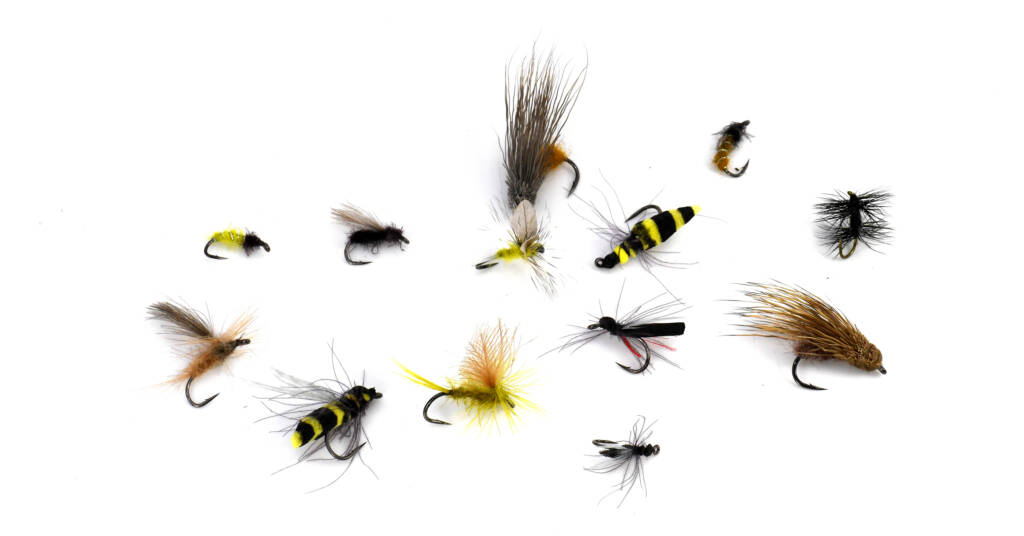Laxa in Laxardalur
Want to catch 8lb+ brown trout on dry flies?
The Laxá River drains out of Myvatn; the sixth biggest lake in Iceland. The river meanders a little less than 100 kilometers downstream through undulating terrain in Iceland‘s Nordurland district some 500 kilometers from the capital, Reykjavik. Laxá means salmon in Icelandic, and it is essentially a salmon river – but a dammed one. And this, at least in part, explains why the brown trout fishing is soo good. The dam, which is situated 20 kilometers from the ocean, effectively prevents the salmon from traveling futher up the rivershed, thus providing the brown trout with a perfectly suited and protected habitat all their own.
Laxá‘s brown trout fishery is divided into two different beats; Laxá in Myvatnsveit and Laxá in Laxardalur, which comprise more than 30 kilometers of perfect and crystal clear brown trout habitat. Laxá in Myvatnsveit is the upper beat, and it consists of myriads of pools, pockets, lava shelves, back waters and riffles, which are interruptet by one island and gravel bar after the other.
Laxá in Laxardalur, on the other hand, is more sedate and wide – not unlike many of Iceland‘s famed salmon rivers. This part of the river, which is found immediately below Mavatnsveit, is more than 300 meters wide in certains spots. However, there are very few sections of the river that can‘t be crossed in a pair of waders – and the bottom, which primarily consists of fine lava sediments and gravel, is unproblematic to wade.
Licenses for Laxadalur‘s beats include lodging. The lodge is called Raudhólar and it is an ambient full-service lodge situated conveniently on the eastern shores of the river. It was completey refurbished in 2019, and it accommodates 10 fly fishermen, which are offered their own private rooms with modern bathrooms, central heating and comfortable beds.
The fishing is split into two sessions. The first one is from 8:00 – 14:00, and it is followed by lunch at the lodge. The second session lasts from 16:00 – 22:00, and it is concluded by dinner at the lodge. The season runs from May 29th until August 28th, and prime-time is from the beginning of July until the middle of August. (This is when the dry fly fishing is typically at its best).
Mandatory catch and release practices were introduced in 2017. Before then, between 1600 and 2000 fish were killed every season. Since 2017, the numbers and size of the fish in Laxá have exploded, and the average fish in the river is now somewhere in the vicinity of 60 centimeters. Every year, multible fish exceeding 70 centimeters are caught, specimens up to 76 centimeters have been caught on dry flies, and fish up to 84 centimeters have been caught on streamers.
Because the fish are generally well-nopurished and in fantastic ovarall condition it‘s not uncommon to catch brown trout over four kilos, and the biggest fish in the river probably weigh around 7 – 8 kilos. For an arctic river with a native and self-reproducing strain of brown trout, this is very impressive in deed!
If you visit Laxá in Laxardalur early in the season, you might also find yourself catching big land-locked arctic char, as these fish migrate downstream from Myvatn during the winter months. Otherwise, there are no other distractions from the brown trout fishing. The brown trout are numerous. And they feed actively and intensely throughout the whole summer.
The Fishing
There are many fish in Laxá in Laxardalur, but you shouldn‘t necessarily expect to catch a lot of fish there. For that, the water is, quite simply, too clear and the fish too savvy. 2 – 3 fish per day is what you can realistically expect to catch – if you fish hard all day, that is.
Laxardalur is divided into six smaller beats, encompassing both the eastern- and western shores of the river, and they are rotated among the lodge guests on a daily basis. There is nearby parking at the best pools and runs, and every beat offers more water than you could possibly fish in a whole day. However, in stead of letting it all overwhelm and stress you, it‘s a good idea to stay calm and fish the most promising holding spots with great care and patience.
Early in the season, you‘ll be concentrating on covering water effectively either with weighted streamers, which are swung cross-current at a sedate pace with frequent upstream mends, or with indicator nymphs. Some of the most popular patterns include Zonker TC streamers from Fulling Mill in sizes 6 – 2, Grey Ghosts and Rabbit Zonkers. With regards to nymphs, especially size 10-18 jig-nymphs in natural colours along with red or orange Squirmy Wormies, are safe bets. These flies can be bounced along the bottom, and they‘re easy for the trout to see and pick up.
As the season progresses and summer arrives, Laxardalur‘s trout turn their attention increasingly towards the surface, and here they typically rise to different midges and sedges. At this time of year, most people completely switch over and focus on sight-fishing with dry flies. For this type of fishing, 9‘ 4-weight fly rods, WF floating lines and 5 – 6 meter long leaders, which can be mended and manipulated; and which are tapered to a 0.14mm tippet – are typically used. For streamer- and nymph fishing, on the other hand, heavier equipment is used: 9‘ 6-weight fly rods, WF floating lines with short and powerful tapers and 4 – 5 meter long fluorocarbon leaders with 0.20mm tippets.
Dressing up for the Occasion
The weather in Iceland can be unpredictable, and some of Laxardalur‘s guests have experienced waking up to 20 centimeters of snow in the middle of July. That should amply underline the importance of packing warm- and weatherproof clothing. Additionally, the water temperatures are quite moderate all year round, so you‘ll need up to three wool layers or a thick fleece layer (for instance Simms‘ Fjord Pants) in addition to a pair of wool core bottoms. Also, make sure to bring warm upperbody layers – preferably wicking ones, since you‘ll be alternating a lot between mobile and stationary fishing.
A Gore-Tex shell jacket, which breathes and – more importantly – creates an effective barrier against wind, rain, and snow is essential. Furthermore, it is highly recommended to bring wool fingergloves, a beanie, and a fleece Buff to keep your neck and ears warm, when the winds are really howling.

Logistics
There are many convenient flights to Iceland; a place that is generally well-connected to the rest of the world. Icelandair offers flights to the capital Reykjavijk all-year-round at very favourable prices. If you book well in advance, you should be able to find return tickets in the 200-250 Euro range, and there‘s always the possibility of doing a stop-over in Iceland for a bit of fishing, if you‘re traveling elsewhere. Additional information about Icelandair‘s flights to and via Iceland can be found here: www.icelandair.com
In order to drive along Laxa in Laxardalur and get to the individual beats, it‘s definitely an advantage to rent a 4×4 of a certain size – one that, as a minimum, matches a Duster Dacia. GoIceland (www.goiceland.com) offers a wide selection of 4×4‘s, and they can help you find just the right car. Schedule for an approximately 7-hour drive from Keflavik to the river. It‘s a 500 kilometer drive, but many of the roads are relatively small and winding.
BOOKING INQUIRY
*Disclaimer: In the Loop Magazine is in no way liable for the execution of trips booked via our contact form. In the
Loop Magazine merely liaises and forwards information requests.
All bookings and related services are handled by the actual lodges and guide agencies.













